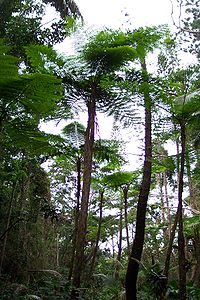- New Caledonia rain forests
-
The New Caledonia rain forests are a terrestrial ecoregion, located in New Caledonia in the South Pacific. It is a tropical moist broadleaf forest ecoregion, part of the Australasia ecozone.
Contents
Setting
The ecoregion covers the windward eastern side of Grand Terre, New Caledonia's mountainous main island, as well as the smaller Loyalty Islands to the east and the Isle of Pines to the south of Grand Terre. The ecoregion covers an area of 14,600 square kilometers (5,600 sq mi).
Grand Terre is a long island that runs approximately north-south, with a mountain range down the center with five peaks that exceed 1500 meters elevation. The Loyalty Islands and Ile des Pins are much lower. New Caledonia lies astride the Tropic of Capricorn, between 19º and 23º south latitude, 1,200 km east of Australia and 1,500 km northeast of New Zealand.
The climate of the islands is tropical, and rainfall is highly seasonal, brought by trade winds that usually come from the east. Rainfall averages about 1,500 mm yearly on the Loyalty Islands, 2,000 mm at low elevations on eastern Grand Terre, and 2,000-4,000 mm at high elevations on Grand Terre. The western slopes of Grand Terre, which are in the rain shadow of the central mountain range, are much drier, and are home to the New Caledonia dry forests ecoregion.
New Caledonia is an ancient fragment of Gondwana, the southern supercontinent. It separated from Australia 85 million years ago, and remained attached to New Zealand until 55 million years ago. It has been islolated from other land masses since then, although a number of plants and animals have been able to cross the straits separating New Caledonia from neighboring islands.
Flora
The New Caledonia rain forests are made up of three predominant forest types. The lowland rain forests cover the Loyalty Islands, and the Iles des Pines and the lower elevations of Grand Terre. Montane forests cover the higher elevations of Grand Terre. The wet maquis forests of Grand Terre are low shrub forests found on rocky soils derived from ultramafic rocks.
The predominant flora of New Caledonia rain forests is derived from the Antarctic flora of ancient southern Gondwana. Like the Australian rainforests and the temperate forests of New Zealand, conifers of the southern hemisphere families Araucariaceae and Podocarpaceae are mixed with angiosperm trees, including the southern hemisphere genus Nothofagus and trees and shrubs of families Myrtaceae and Proteaceae.
The lowland forests are a generally a mixed-species composition, interspersed with some single species stands. The predominant conifers are Araucaria columnaris, A. bernieri, Agathis lanceolata, A. ovata (Araucariaceae), and Dacrydium araucarioides, Dacrycarpus vieillardii and Falcatifolium taxoides (Podocarpaceae). Predominant angiosperm trees include Montrouziera cauliflora, Calophyllum neocaledonicum, Dysoxylum spp., Neogullauminia cleopatra, and Hernandia cordigera, together with species of the Proteaceae genera Kermadecia, Macadamia, and Sleumerodendron. Araucaria, Callistemon, and Nothofagus predominate in the single-species stands.
The Montane rain forests are also mixed-species, predominantly the conifers Araucaria, Agathis, Podocarpus, Dacrydium, Libocedrus, and Acmopyle, and the angiosperms Metrosideros, Weinmannia, Quintinia, and Nothofagus.
The Maquis forests hold a great variety of species, with many endemics. The ultramafic rocks, which formed in the deep ocean, are rich in metals, including nickel, magnesium, chromium, and manganese, which are toxic to many plants. The predominant trees are stunted Araucarias.
Fauna
New Caledonia has one of the most enigmatic birds of the world, the endangered Kagu. It is related to the cranes and it lives very hidden. It is also the heraldic bird of the island. Another endemic bird is the New Caledonian Rail. This critically endangered bird could be extinct but many believe that it still persists. Both the New Caledonian Owlet-nightjar and the New Caledonian Lorikeet are believed to persist under similar circumstances. There are also another twenty or so endemic birds on the island, including the tool-using New Caledonian Crow. See Endemic birds of New Caledonia for more details. The seashells from New Caledonia are in great demand by collectors.
Conservation
See also
References
Flannery, Tim (1994). The Future Eaters. Grove Press, New York.
External links
Wikimedia Foundation. 2010.

